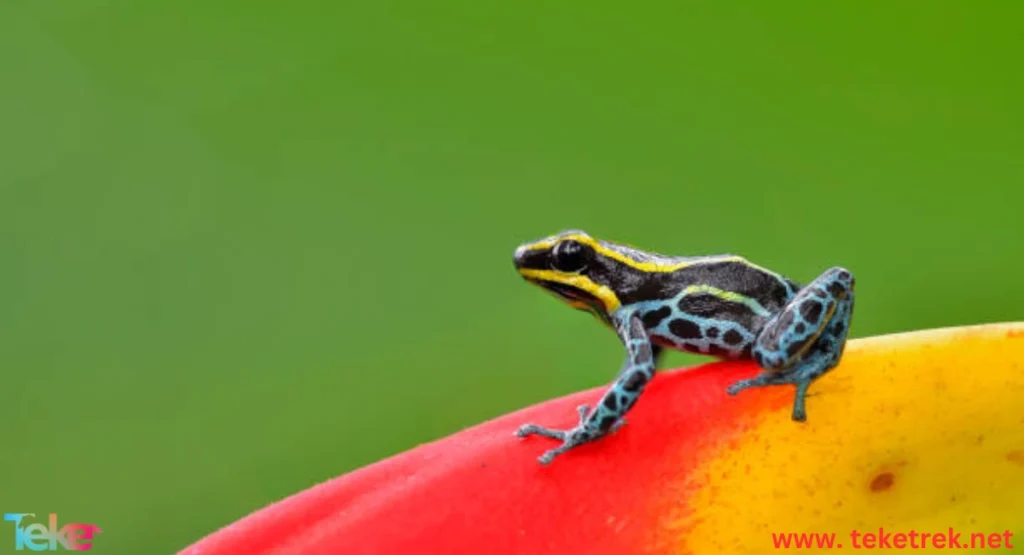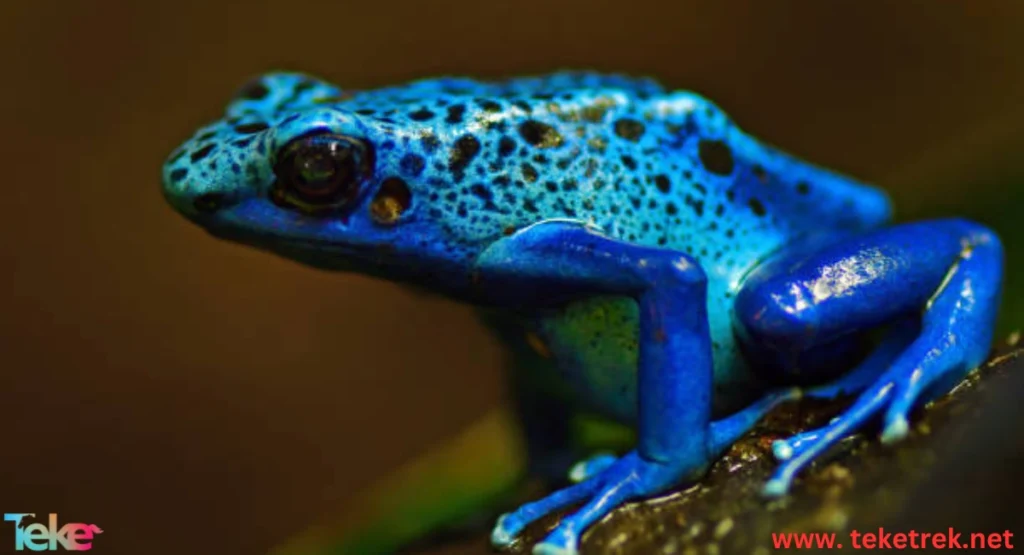Poison dart frogs are among the most dangerous amphibians on Earth. Despite their small size, their skin contains powerful toxins that can be lethal to predators and even humans. These frogs are known for their bright colors, which serve not only as decoration but also as a warning signal to potential threats. They inhabit the rainforests of Central and South America, acquiring their toxicity from a diet rich in poisonous insects. Beyond their ecological role, their toxins have attracted scientific interest for developing effective medicines. In this article from teketrek, we will explore the secrets of these unique creatures, their types, habitats, and the extent of their danger to other organisms.
What Are Poison Dart Frogs?
Poison dart frogs, also known as dart frogs, belong to a group of tropical frogs found in the Amazon and other tropical regions of Latin America. These frogs acquire their toxicity from their diet, feeding on poisonous insects such as ants, mites, and termites, which saturate their skin with toxins. The level of toxicity varies among species; some are highly toxic with bright colors, while others are less toxic with duller shades.

Famous Species of Poison Dart Frogs
There are many fascinating species of poison dart frogs, including:
- Golden Poison Frog (Phyllobates terribilis) – One of the most toxic frogs in the world.
- Blue Poison Dart Frog (Dendrobates tinctorius) – Features a bright blue color with black spots.
- Phantasmal Poison Frog (Epipedobates tricolor) – Recognized for its unique tricolor pattern.
- Zimmerman’s Poison Frog (Ranitomeya variabilis) – Small in size but highly toxic.
- Red-Backed Poison Frog (Ranitomeya reticulata) – Has a striking red coloration.
- Strawberry Poison Frog (Oophaga pumilio) – Resembles a bright red strawberry.
- Lovely Poison Frog (Phyllobates lugubris) – Displays a unique and attractive color pattern.
- Golfo Dulce Poison Frog (Phyllobates vittatus) – A rare species.
- Green and Black Poison Frog (Dendrobates auratus) – Features a mix of green and black colors.
- Corroboree Frog (Pseudophryne corroboree) – Native to Australia, distinguished by bright yellow and black stripes.
Where Do Poison Dart Frogs Live?
Poison dart frogs inhabit the rainforests of Central and South America, where the humid climate provides an ideal environment away from permanent water bodies. They prefer to stay near the forest floor but sometimes climb trees up to 10 meters high. They can also be found in swamps, wooded areas, grasslands, and even agricultural fields, though deforestation threatens their natural habitats.
How to Identify Poison Dart Frogs?
Poison dart frogs are known as the “jewels of the rainforest” due to their bright colors, which serve as a warning to potential predators—an evolutionary strategy known as aposematism.
Some species also use their colors for camouflage. For example, Dendrobates tinctorius blends its yellow and black pattern with its natural surroundings, as highlighted in a 2018 study published in the journal PNAS.
While poison dart frogs share similar body structures with other amphibians, they grow at a slower rate and remain relatively small, reaching a maximum length of 2 to 5 cm. Compared to other frog species, they are tiny. Additionally, they have limited jumping abilities, with a maximum recorded jump distance between 10 and 20 cm.
Unlike most frogs, poison dart frogs are not good swimmers. Their relatively short limbs, which limit their jumping distance, also hinder their ability to swim efficiently.
The Role of Poison Dart Frogs in the Environment and Wildlife
- Maintaining Ecological Balance (Predation):
- They act as predators, feeding on small insects and helping control their populations.
- They serve as prey for certain animals resistant to their toxins, such as the snake Erythrolamprus epinephalus.
- Indicators of Environmental Health:
- Their sensitivity to pollution and climate change makes them important bioindicators of ecosystem health.
- Symbiotic Relationships:
- With plants: Some species lay their eggs in small water-filled cavities in bromeliad plants, creating a mutual relationship where the plants benefit from the tadpoles’ waste.
- With microorganisms: Their toxic secretions help combat harmful parasites.
- Indirect Role in Seed Dispersal:
- As they move through the forest, they may contribute to spreading plant seeds or fungal spores that stick to their bodies.
- Scientific and Medical Importance:
- Medicinal Toxins: The compound Epibatidine from their toxins has been studied as a potent painkiller.
- Evolutionary Research: They serve as an excellent model for studying aposematism (warning coloration) in evolutionary biology.

Are Poison Dart Frogs Endangered?
Yes, poison dart frogs face several threats, including:
- Deforestation: Leads to habitat loss.
- Climate Change: Affects humidity levels in rainforests, endangering their survival.
- Fungal Diseases: Such as Chytridiomycosis, which has devastated amphibian populations worldwide.
- Illegal Trade: Many species are captured and sold unlawfully.
Conclusion
Poison dart frogs are not just visually striking creatures; they play a vital role in maintaining ecological balance and have significant medical value. However, they are at risk due to human activities and environmental changes. Conservation efforts, such as establishing protected areas and raising awareness about their ecological importance, are crucial to preventing their exploitation and preserving biodiversity.





